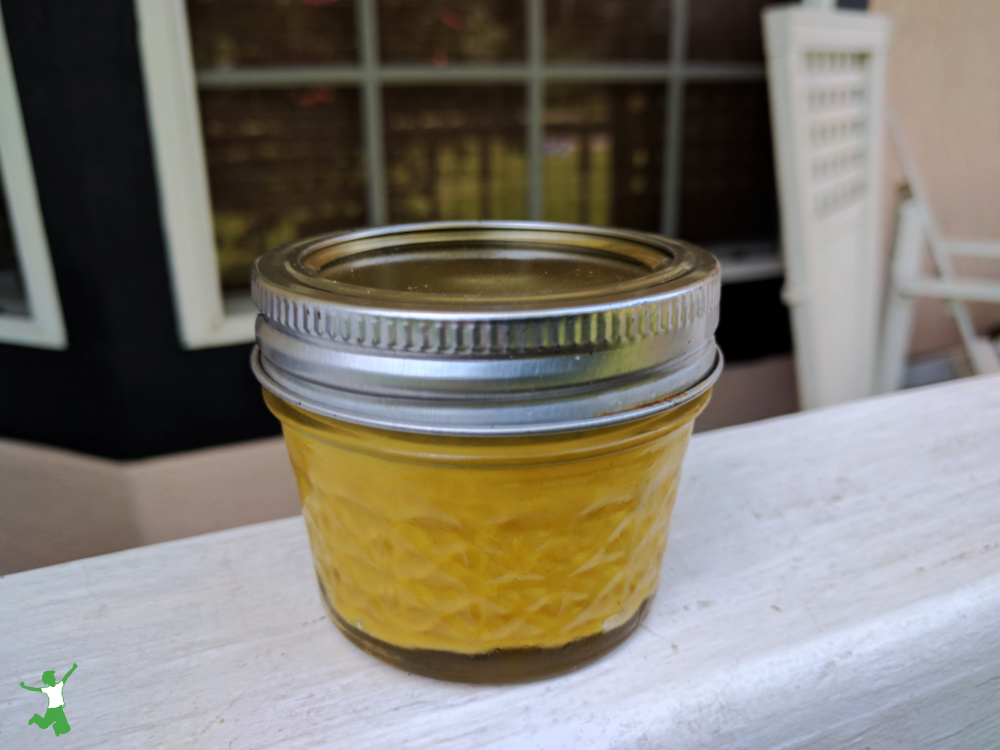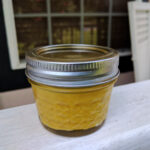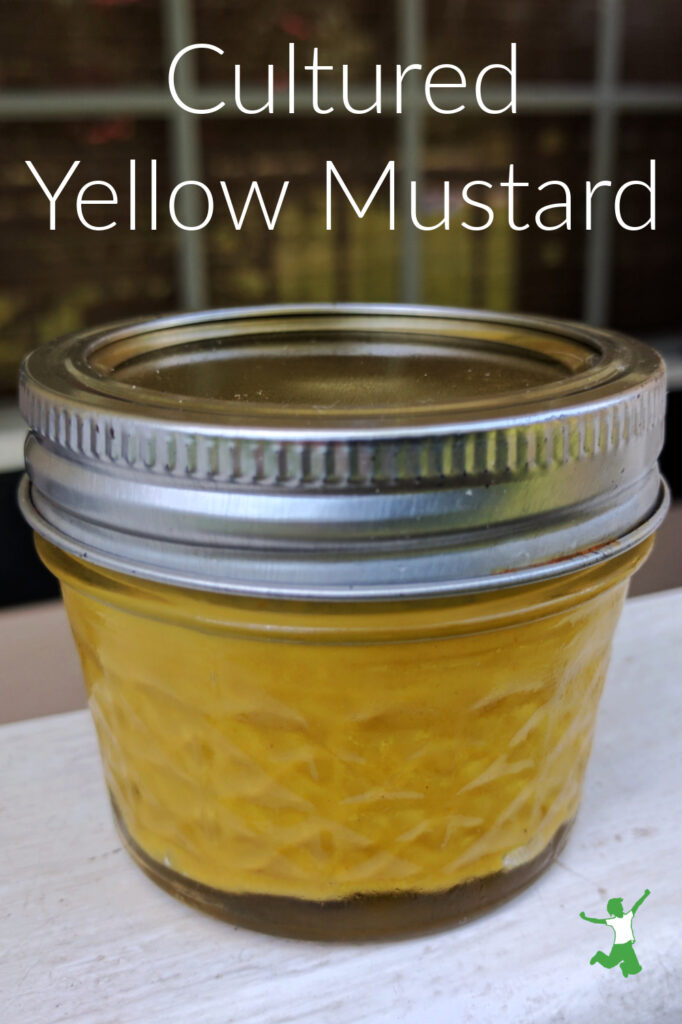Table of Contents[Hide][Show]
A simple recipe for fermented mustard, a probiotic-rich, lightly cultured condiment to facilitate the digestion of cooked foods enjoyed with it!

Mustard is an ancient spice that traditional peoples used all over the world for both culinary and medicinal purposes. No surprise then that homemade mustard is a traditional condiment as well!
In Ancient Egypt, mustard was used as respiratory therapy. Later, in the Middle Ages, healers treated asthma with this pungent, sulfurous seed.
The English physician Herberden also advised the use of mustard seed for the treatment of asthma (source: Nourishing Traditions).
The process of grinding the mustard seed releases compounds from the sugar molecule that have a strong odor and a subsequently irritating effect on any skin or mucous membranes that come in contact.
This may explain its traditional use for respiratory ailments given its almost homeopathic effect on the sinuses and lungs.
Mustard as Healthy Condiment
When used as a condiment, mustard is usually something people either very much enjoy or totally avoid. There doesn’t seem to be much middle ground when it comes to mustard!
While you can procure good quality organic mustard at the healthfood store, it is still better to make it yourself.
Homemade certainly tastes better and sits more softly in the stomach, in my opinion.
Cultured Mustard
Taking the extra step of culturing organic mustard makes it optimally nutritious too.
It is also more beneficial and potent to the respiratory and digestive systems due to the presence of beneficial probiotics.
The enzymes present in probiotic mustard also assist the digestion of any cooked foods served with it.
If you’ve never fermented condiments before, cultured yellow mustard is a good one to try first!
Feel free to play with the spices and adjust to your own personal taste if you prefer your mustard stronger or milder.
If you enjoy making your own condiments like I do, be sure to try this fermented ketchup recipe too!
Tip: This cultured mustard makes a delicious honey mustard dressing and marinade when blended with extra virgin olive oil, raw honey, and apple cider vinegar.

Fermented Yellow Mustard Recipe
A simple recipe for fermented mustard, a probiotic, cultured condiment to facilitate digestion with whatever cooked foods are enjoyed with it!
Ingredients
- 1/2 cup ground yellow mustard preferably organic
- 1/4 cup raw apple cider vinegar preferably organic; do not use pasteurized ACV
- 1/4 cup filtered water
- 1 tsp sea salt
- 1/4 tsp ground turmeric preferably organic
- 1 pinch garlic powder preferably organic
- 1 pinch paprika preferably organic
Instructions
-
Mix all ingredients well in a pint size mason jar. The texture should be as smooth and nongrainy as possible. Leave at least 1 inch at the top to avoid the risk of mold on the ferment. Screw on the lid tightly.
-
Leave on the counter at room temperature for 1-2 days. After fermentation time is complete, open the lid and stir well, close the lid tightly, and then refrigerate.
-
This homemade mustard gets thicker after fermentation and refrigeration. It also gets more yellow as time goes on. It is delicious and so much better tasting than organic mustard from the store!
-
Fermented homemade mustard will last several months refrigerated.
Recipe Notes
You may use homemade ACV instead of store bought. It is certainly cheaper to make your own!









Perfect timing! I just told my hubby I was cleaning out the door of our fridge this week and making you ketchup and mayo and now MUSTARD!!! Yeah! No more icky condiments in our fridge! Switching to natural and learning all this is great but so hard to see others still eating it. I am watching 2 boys today and had to make them pbj on white bread, chicken rings (um….) and mac n cheese… my kid had steak, pinapple and homemade sprouted crackers… and he didn’t argue!
Way to go Jackie! Be sure to taste the mustard as you are mixing it up for the first time to be sure you like the flavor of it. I like my mustard kind of strong so play with it so you get it just right for your tastebuds.
Yay!!!we make all the fermented bevs and condiments too and love!!although I cant get my 5&6 year old girls to use the ketchup. They LOVE the organic storebought and I.cant seem to tweaj it to where theyll use it. But they eat everything else so no complaints from this mama. 😉
My kids won’t eat it either…..I think it is the fish sauce that turns my gang off….I wish that you didn’t need to use it. Maybe if we added a different starter like caldwell’s???
I don’t use the fish sauce. Is there a reason why you “need” it. I just omit it. I don’t mind it in there, I just don’t trust any of the brands at my Asian market.
I didn’t use the fish sauce in my first and only ever fermented ketchup, although I had to scale down because I got a bunch of homegrown tomatoes and made my own tomatoe paste, but a large skillet and small only gave me 2C of tomatoe paste. Although I used the small end of the maple syrup 1/4 c it was too sweet for me but it was great otherwise. Oh and I substituted some coconut alternative for a soy sauce. Cant wait to make this mustard.
I never thought about making my own mustard. I most definitely need to try this!
I’ll be trying this. Always happy to add another probiotic food to our diet…….thanks.
This looks SO ridiculously easy!
@Jennifer .. yes organic ACV will work but raw will give the best results.
@April So glad you are on the fermentation wagon! Condiments are an easy way to get some raw enzyme and probiotic rich foods into you with a cooked meal like a grassfed burger. Much easier for the kids too if they aren’t big on the sauerkraut, etc as a fermented side dish.
Could you add 1 Tbsp of whey to add to the fermentation process or would it be to “acidy” with the addtion of the cider vinegar?
The NT recipe uses whey and lemon juice. I prefer ACV by itself and it ferments fine. Go ahead and try it though if you like. Fermentation is a very creative process and there is no one right answer.
Wow, at this rate, I won’t have to buy anything pre-packaged again :)! Our family just loves your recipes for homemade cereal, ketchup, teriyaki and bbq sauce. Thank you, Sarah,for all the time you put into creating such yummy and nutritious recipes!
I read that if you add black pepper, the assimilation of turmeric in your body greatly increases.